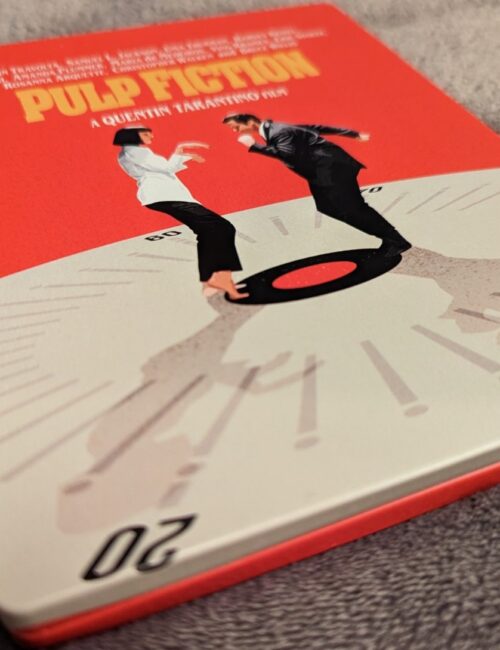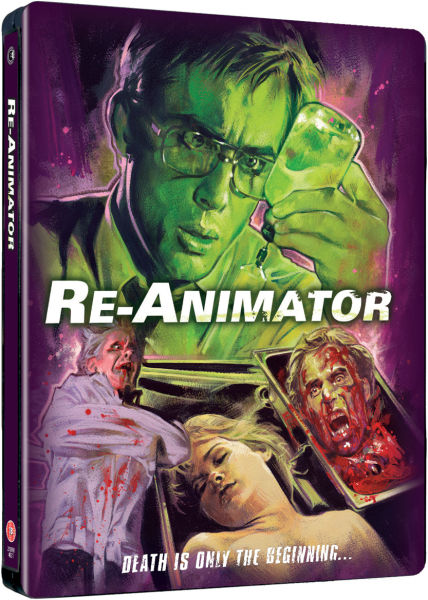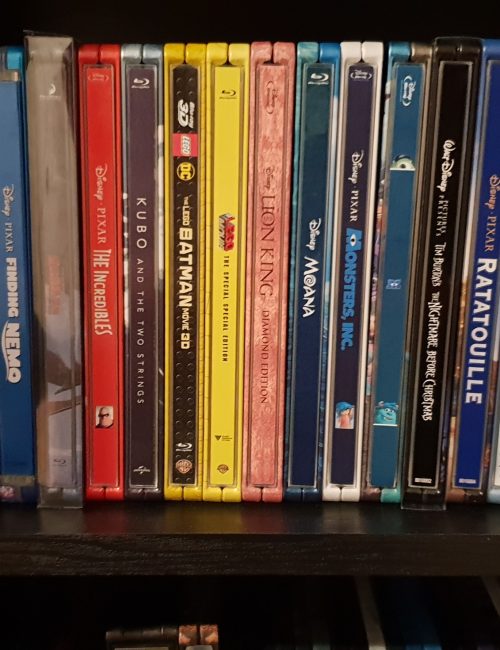From The Bottom of The Barrel #001 – Hellboy (2004) archive DVD review
Talk about this release on Slack
Many, many years ago I was a reviewer for the now defunct DVDDebate.com website, which was, at the time, one of leading sources of international DVD news and reviews.
While things are a bit quiet on the steelbook front, I’ll be dusting off some of those reviews for your reading.. erm.. pleasure…?
Anyway, here’s the first one, which is for the 2-Disc Region 1 release of Guillermo del Toro’s superb 2004 adaptation of Hellboy. When looking at the comments on video and audio, bear in mind it’s all relative, and this was in the days before Blu-ray, so what looked good back then obviously wouldn’t stand a chance against more recent formats.
Studio: Columbia TriStar Home Entertainment
Packaging:
Extras: 2 Audio Commentaries, ‘Making Of…’ Documentary, 8 Branching DVD Comics, 8 Branching On-Set Featurettes, Storyboards, 4 ‘Hellboy Recommends” Animated Short Films, Storyboard Comparisons, Deleted Scenes, Animatics, Scene Deconstruction, Poster Gallery, Trailers, TV Spots, DVD Rom Content
Aspect Ratio: 1.85:1 Anamorphic Widescreen (NTSC)
Audio: Dolby Digital 5.1 English (448Kbps) & French (384Kbps)
Subtitles: English, French
Director: Guillermo del Toro
Release Date: July 27th 2004
Rating/Certificate: US – PG-13
Region: US – Region 1
“There are things that go bump in the night, Agent Myers, make no mistake about that. And we are the ones who bump back.”
Film
Mexican director Guillermo del Toro is one of those talented few who are able to move easily between low budget, personal, independent films, and big budget blockbusters. After some short film and television work, his first feature film, Cronos, a low budget vampire movie, was a multi-award-winning festival hit, and a pretty unique calling card to Hollywood. This was followed up by Mimic, for Miramax’s genre division Dimension Films. Despite fall outs with the notoriously meddlesome Weinstein brothers, del Toro still managed to craft an effective chiller. Next it was back to the indies, with the superb The Devil’s Backbone, a restrained and truly creepy ghost story that proved that Asian film makers don’t quite yet have the monopoly on spine-tinglers. It was then back to Hollywood for Blade II, one of the finest comic book-based movies of recent years, not to mention one of the best sequels ever made (in my ever-so-humble opinion, of course). With a distinctive body of work behind him, del Toro began filming on a project that would combine his personal passions – he bought the rights to make the film over 5 years ago, and had been planning it with creator Mike Mignola since then – with the kind of big studio budget that would do it all justice.
In 1944, in a remote part of Scotland, a secret, occult division of Hitler’s army has resurrected the infamous Rasputin (Karel Roden), and are attempting to open a portal to another dimension, to bring the mythical Ogdru Jahad – the seven gods of chaos – to Earth. Here, under the Nazi’s control, they will wipe the Earth clean, allowing Hitler to rebuild it as he sees fit, and with total power. A small platoon of American soldiers is there to stop him, and they have brought along paranormal advisor Professor Trevor ‘Bloom’ Bruttenholm (Kevin Trainor) to stop the Nazi’s plans. With Rasputin seemingly dead, and his followers, including the deadly Kroenen (Ladislav Beran) and the devoted Ilsa (Bridget Hodson) on the run, the soldiers find a bizarre little creature – a bright red baby with horns and a tail – that they name Hellboy.
60 years later, and FBI agent John Myers (Rupert Evans) is transferred to the top secret Bureau for Paranormal Research and Defence, headed by the now elderly Professor Bloom (John Hurt). Myers is quickly introduced to the BPRD’s top two operatives – Abe Sapien (played by the amazingly nimble and lithe Doug Jones, and voiced by the wonderful David Hyde Pierce), an amphibious creature of unknown origins, and Hellboy (Ron Perlman), who, although now 60 in human terms, has aged to the equivalent of his early 30s. Myers discovers that Hellboy is not the most friendly of workmates, especially now that the subject of his unrequited love, the firestarter Liz Sherman (Selma Blair) has left the organisation and admitted herself to a local medical institute where medication and isolation have helped her to control her powers. To make matters worse, the Bureau is under threat of closure from FBI boss Tom Manning (Jeffrey Tambor) who is growing weary of having to explain away Hellboy’s ever-more-frequent public appearances.
Hellboy and Abe lead a crack squad of monster hunters, and it’s not long before Myers joins them after a disturbance – and several deaths – at a local museum. Their investigations lead them to realise that Kroenen and Ilsa are still very much alive, and that, along with a newly resurrected Rasputin, their plans to open the portal again are back on track. After a deadly tragedy at BPRD headquarters, Hellboy, Abe, Myers, Liz and Manning head for Russia to thwart the evil doers’ plans. What they don’t realise is that they are walking right into a trap, as Hellboy is the one piece of the jigsaw that Rasputin needs to succeed…
So, how does this compare to other comic book-based films? Especially considering that del Toro himself directed Blade II, one of the best already in existence. Having never read the original comics I can’t say how close this is to the source material, but as a piece of entertainment, in its own terms, it’s very good indeed, with much to recommend it. That’s not to say it’s perfect, but I’ll cover its minor poor points shortly. For now, the good bits…
Firstly, the world that del Toro has created is pitch perfect for the story and the characters. In this world, Hellboy is an urban myth, like Bigfoot or UFOs, occasionally captured on film, in grainy photos or on shaky camcorder footage. Like all good myths, Hellboy even has a comic book based on him, though, as he says to Myers, he hates them because they never get his colour right. Meanwhile, Manning is constantly having to go on TV to claim that neither Hellboy nor the BPRD exist. This self reference is played well, and never gets too cute, but instead sets just the right tone for the film that follows.
Guillermo del Toro and his creative team, including the heavily involved Hellboy creator Mike Mignola, cinematographer Guillermo Navarro, Rick Baker and others work wonders on a technical level to bring the world to life. The Rick Baker supervised Hellboy and the Steve Wang sculpted Abe Sapien makeups are simply stunning, allowing the performers an amazing amount of physical and facial expression, despite being covered in latex. The integration of physical and CGI effects is well handled, with both Hellboy and Abe being replaced by digital ‘stuntmen’ on several occasions. More impressive is the work done on the most encountered monster featured in the film. Sammael is a creature that is not only reborn whenever it dies, but multiplies each time. One sequence near the end of the film sees 3 ‘real’ Sammaels sharing the frame with digital companions, and it’s nigh on impossible to tell them apart. All of the digital performers have a real sense of weight and mass that is often lacking in CGI work, and they blend in extremely well.
The performances are a bit more mixed. Firstly, after seeing his performance here, it’s safe to say that Ron Perlman was simply born to play Hellboy. I can’t think of another single actor who could play the part, and he really makes it his own. With a world-weary, take no crap attitude, Perlman steals the picture, and his is one of the most spot on actor to character pairings I’ve ever seen. The team of Doug Jones and David Hyde Pierce as Abe Sapien works to brilliant effect. Jones’ physical performance as Abe is eerily measured and restrained, while Hyde Pierce brings the same kind of snooty self assuredness to the voice as he does to his character of Niles in the sitcom Frasier. It goes without saying that John Hurt is superb as Professor Bloom, with a real air of authority and wisdom, mixed with fatherly love for Hellboy, along with an at times almost playful mood.
On the downside, the rest of the cast fair less well. Selma Blair is good but a bit wasted in a rather under written role, and I would hope that Liz Sherman is further developed and given more to do in any sequels. Rupert Evans is again fine but wasted in a role that is really designed to give the audience an outsider’s view point to the story. That’s a good idea, but the character is a little too bland to be really interesting. Rasputin and Ilsa border on the level of pantomime at times, and their back story is hinted at but remains under developed, leaving us not really knowing – or caring – about them. In his commentary, del Toro identifies this as a weakness, and expresses his intentions to reinstate footage back into his Director’s Cut to flesh out these two characters.
Kroenen is the kind of character – a bit like Darth Maul in the Phantom Menace – who is superb physical eye candy, but is again underdeveloped as a character, leaving the viewer really wanting to see more of him in action, and to also learn a bit more about him. Lastly, Jeffrey Tambor – a name you may not recognise, but a face you will know instantly – brings some nice moments of comic relief, as his frosty relationship with Hellboy warms predictably.
As I said, the film as a whole is great fun, but it does lack the aforementioned development of some of its supporting characters, as well as suffering at times from slow pacing. Whereas Blade II is pretty much non-stop from beginning to end – and even during the slow parts you felt it was building up to something big – Hellboy occasionally lacks the raw energy of del Toro’s previous film, and while never ever boring, it does sag a little at times. These are minor grumbles, and will hopefully be resolved by the Director’s Cut, but in the meantime, Hellboy remains a very good film, rather than a truly great one.
On a brief technical note, one blindingly obvious gaff occurs during the film. As Hellboy walks into a room, the shot is flipped so that his Right Hand Of Doom is actually on his left hand. At first I thought this might be a mastering error with the disc, but del Toro points it out himself during his commentary. Apparently it was done on purpose to match the continuity of the character’s movement across the screen with the previous shot, but it’s such a distracting event I do hope he ‘fixes’ it somehow for the Director’s Cut.
Video
As expected for a recent release, the transfer for Hellboy is very fine indeed, but, possibly due to the amount of room taken up by all the extras, doesn’t quite come up to the standards that we have come to expect for new films from Columbia TriStar.
Good points first. Detail levels are consistently high, and this is especially noticeable with close ups on Hellboy and Abe, where all the fine work by the effects team is reproduced with pin sharp clarity. On Hellboy’s face, for example, all of his scars, skin pores and individual hairs show up, while on the larger sets, all manner of incidental background detail is visible. The film’s colour palette goes through some real extremes, from deep night time blues, to warm sepia tones, underwater deep greens, to almost black and white, washed out snow-bound exteriors; but never once does the transfer look under or over saturated. Naturally, the one constant through all these settings is Hellboy’s bright red skin, and it remains accurate and steady throughout. Black levels and contrast are exceptional. Hellboy is at times an extremely dark film, but despite some areas of the frame dropping off into almost complete blackness, detail is still visible.
As I said though, it’s not quite perfect. The main problem is a few too many compression artifacts for my liking. While generally very smooth, some backgrounds and smoky scenes tend to become pixelated and blocky, while some more defined shapes and and lines occasionally look a little rough around the edges. It’s no worse than many new releases, and to be honest still better than most, but, compared to Columbia TriStar’s own high standards, it isn’t quite up to scratch.
On a more positive note, other compression artifacts, especially motion blur, are absent, while edge enhancement is rarely used, and barely noticeable when it is. Preempting a question often asked, on-screen titles for place names and the like are ‘burnt in’, and on the actual film itself, while dialogue spoken in another language has player-generated subtitles. This is a little irritating if only for the mismatching styles.
Audio
While the video transfer seems to suffer a slight lack of breathing room, the audio has no such limitations, offering a barnstorming listening experience, and coming up trumps with probably the most impressive soundtrack I’ve heard this year, covering all the requisite extremes, from pin sharp, crystal clear clarity and subtlety, through to window shaking, bowel loosening aggressiveness.
Firstly, even amid all the carnage and destruction, dialog is always clear. There’s a fair bit of exposition in the film, so it’s important that we can hear every word, and thankfully the soundtrack doesn’t disappoint. At the other end of the scale, explosions, bangs and crashes are wonderfully taken care of, but again, the little details aren’t lost. As Hellboy is thrown through a series of wood and glass display cases, the hard impact is both heard and felt, but you can still hear the individual pieces of glass flying off and tinkling across the sound field.
Bass activity is very strong and active, but remains well controlled and never overpowering, while directional effects are used brilliantly. Bullets, explosions, debris, leaping creatures and more fly around the the whole sound field with pin point accuracy, and will have you almost ducking for cover. Guillermo really knows how to use sound in his films, and here he manages to mix both the aggression that was found in the mix for Blade II with the more sinister and subtle effects from Mimic to wonderful effect. Any future DTS release will have its work cut out trying to top this Dolby Digital effort, as this is definite demo material.
Extras
Hellboy arrives on a 2-Disc special edition that really is bursting at the seems, with extras crammed onto both discs.
Disc 1
Video Introduction (0m25s). This brief piece-to-camera by del Toro gives a quick run down of what extras you will find on Disc 1.
Creator Commentary. Guillermo del Toro is joined by Co-Executive Producer and Hellboy creator Mike Mignola to discuss the origins of the character and the long gestation of the film. The pair first met several years ago, and they have been working together ever since to bring the story to the screen. It’s clear that the two have a great relationship, and the commentary is an easy going, chatty track as the two reminisce about the making of the film. Loads of ground is covered, including the changes that del Toro made to various elements of the mythos and characters, and it’s good to know that with Mignola involved every step of the way, all of those changes had his blessing. Also mentioned are the editing choices made, including scenes that were removed, with plenty of info on what we can expect to see to in the forthcoming Director’s Cut (though I won’t spoil any of that just yet).
Cast Commentary. Hellboy himself, Ron Perlman, is joined by Selma Blair, Jeffrey Tambor and Rupert Evans to talk about the making of the film from their perspective. Having never seen any of Rupert Evans’ work before, it was quite a shock to hear his character’s pitch perfect American accent replaced by his natural English one, but getting used to it didn’t take long. Despite having more participants, this track is not as enjoyable as the first one. Perlman and Evans keep things quite lively, but Blair and Tambor are a little too quiet and dry. While plenty of technical info is given, along with a fair few bits of behind the scenes anecdotes, at times the track seems a bit plodding and unfocussed. I would have like to have heard del Toro on this track as well, helping to move things along with his cast, and perhaps acting as a moderator/interviewer. Despite that grumble, it’s still worth a listen.
Branching DVD Comics. These can be accessed directly from the Special Features menu of Disc 1, or, by selecting the branching option, by pressing the ‘enter’ button of your DVD remote whenever a Hellboy comic icon appears on the screen (selecting this feature disables any subtitles). 8 comics are included, with brand new stories drawn by Mike Mignola and written by Guillermo del Toro. They are: Ragnarok: The Gate of the Dragon, Abe Sapien, The Samaritan, Pancakes, Hellboy’s Belt: The Talismans, Hellboy Scrapbook, Rasputin: A Short Biography and Kroenen. These short pieces – some less than a minute – use some simple animations and scrolling text to help fill in some of the back story to events and characters in the film, and are a nice – though not essential – bit of filler.
‘The Right Hand Of Doom’ Branching Set Visits. As with the DVD comics, these can be accessed directly from the Special Features menu of Disc 1, or, by selecting the branching option, by pressing the ‘enter’ button of your DVD remote whenever a Hellboy’s hand icon appears on the screen (again, selecting this feature disables any subtitles). 8 featurettes are included, and they are: Abbey Ruins, Broom’s Office, Machen Library Alley, Subway Station, Subway Tunnels, Kroenen’s Lair, Egg Chamber and Catacombs. Totaling 18m24s, these are basically fly-on-the-wall pieces, that give a great look at some of the rehearsals and filming as it took place. The site of John Hurt giving his finest regal, royal wave as he whizzes past the camera on a golf cart is a classic ‘blink and you miss it’ moment, and there are several more nice little witty asides from all involved.
Storyboard Track. With this feature, you can see Simeon Wilkins’ storyboards synched up to the onscreen action throughout the film. Once again, switching this feature on disables any subtitles. Unfortunately, despite the impression that the disc may give, the storyboards are not constantly on throughout the film, but instead appear only occasionally, for a few seconds at a time, which is a bit of a shame.
‘From The Den’ – Hellboy Recommends. A slightly odd extra here, with four classic animated short films: Gerald McBoing Boing (6m56), Gerald McBoing! Boing! on Planet Moo (7m11s), How Now Boing Boing (7m21s) and the extraordinary The Tell-Tale Heart (7m47s), based on a story by Edgar Allen Poe and narrated by James Mason. These are all unexpected treats, though quite how they relate the main feature is debatable. I guess del Toro simply wanted to have a little fun and include something a bit more personal than the usual promo stuff. Well worth checking out.
DVD-ROM Content. Penultimately on Disc 1 is a selection of content available via a PC. We get del Toro’s original screenplay, the script supervisor’s notebook, complete with scribbles and Polaroids, and excerpts from del Toro’s notebook. All of these are browsable and printable, and, while not of interest to everyone, are worth at least a quick skim through. Mac owners should note that while the DVD does have a Mac directory on it, with some files in there, the booklet included with the disc does say that the DVD-ROM features ‘may not’ work on a Mac. I guess this may be down to which version operating system is used, but no other information is given.
Trailer. The final feature on the first disc is a trailer for psychological thriller The Forgotten, starring Julianne Moore and Gary Senise, that runs when the disc is started up. This can be skipped to load the main menu.
Disc 2
Video Introduction (0m32s). Selma Blair introduces the 2nd disc, with a brief run though of the content. The rest of the disc is split up into sections:
Egg Chamber
Deleted Scenes. 3 deleted scenes are included, all with an optional commentary from del Toro. Breaking The Ice Wall (0m30s), Cab Ride (1m24s) and Russian Warehouse (2m33s) are presented in non-anamorphic widescreen and Dolby Digital 2.0. The director gives his reasons for removing the footage, and talks about how they might be re-integrated into his Director’s Cut. None of them are essential to the film, but are worth watching.
Hellboy – The Seeds Of Creation Documentary (2h22m43s). This is the epic centre-piece feature of this 2 Disc set, and is exhaustive in its depth and detail. The documentary covers the making of the film in chronological order, starting with the origins of the character and the comics, through to del Toro’s first involvement, pre-production, filming, effects, editing, music, and finally the premiere. All the main players from the cast and crew are interviewed, and no stone is left unturned. What really comes through is the unprecedented involvement of creator Mike Mignola. Too often, creators are sidelined or just plain ignored, but here Mignola was not only a producer, but had hands-on involvement every step of the way.
My only criticism is with the structure – rather than the content – of the documentary. By following things in the order they were filmed, many related subjects, like creature effects or CGI, are split up over the entire running time. We may see talk about Hellboy’s makeup, then half an hour later we get to see Abe Sapien’s, then, another half an hour or so it’s Kroenen’s turn. This is OK, but can make things seems a little disjointed. Personally, I would have preferred a more defined structure to the piece, for example, pre-production, on-set filming, then creature effects all together, then CGI all together, and so on. My grumble is a bit nit-picky though, and as it stands, the documentary is still one of the very best of its kind, and definitely a must see. It’s split into over two dozen chapters that can be accessed individually, or watched all in one go, and is presented in anamorphic 1.85:1 widescreen.
Filmographies & Character Bios. 15 entries can be found here, with cast and crew filmographies, and illustrated character bios.
Kroenen’s Lair
Scene Progression (1m23s). Guillermo del Toro introduces a look at the evolution of a scene featuring the Ogdru Jahad, from his first doodles through to more detailed storyboards, with the finished film playing in a small window at the side of the screen.
Animatics. del Toro introduces about 6 minutes worth of animatics, a mixture of basically animated storyboard and rough CGI, used to plan and block out 4 action sequences. These can either be viewed full screen, or as a split screen comparison with the finished film. You will also find an easter egg here in the form of a hidden animatic for what appears to be part of the original unused opening for the film, which del Toro briefly discusses in his commentary.
Board-a-matics. After another introduction from del Toro, we get just over 8 minutes of animated storyboards, without any CGI enhancement, again used to block out and plan sequences. Another easter egg, in the form of a CGI previsualisation of a post apocalyptic landscape, can be be found here
Storyboard Comparisons. 4 scenes, totaling just under 10 minutes, are presented with either full screen storyboards or split screen comparisons, with a 5th one available as a hidden easter egg.
The features in this section are all pretty similar to be honest, and probably didn’t need to go into so much detail, but it’s nice to have nonetheless.
Maquette Video Gallery
This small section contains gallery views of the original design maquettes created for the following characters: Baby Hellboy, Abe Sapien, Sammael, Ogdru Jahad, The Corpse and Behemoth. Nothing special, but interesting enough if that’s your kind of thing.
Bellamie Hospital
This covers the publicity campaign for the film, starting with 2 Trailers and 9 TV Spots. The trailers are presented in anamorphic Widescreen with 5.1 sound, while the TV spots are 1.33:1 and Dolby Digital 2.0.
Next is a look at the various poster concepts used. There are dozens of abandoned designs here, most of them far, far better than the one finally used. It’s a shame one of these wasn’t used as the cover for the DVD, as some of these are absolutely stunning. Another easter egg can be found here in the form of some pencil sketches that appear to be from the inimitable hand of poster designer/genius Drew Struzan.
Previews
This section contains a selection of trailers for other Columbia TriStar releases. We get Seinfeld on DVD , the full trailer for Spider-Man 2, Spider-Man: The New Animated Series, 13 Going On 30, the frankly horrendous looking White Chicks, Kingdom Hospital, Anacondas: The Hunt For The Blood Orchid (featuring the craptastic Coronation Street reject Matthew Marsden), Resident Evil: Apocalypse, the CGI Kaena and The Forgotten.
Lastly on Disc 2, Columbia couldn’t resist including a sneaky plug for the Hellboy website, where you can go and buy lots of lovely merchandise.
Summary
Hellboy is another extremely well made comic book adaptation, and the latest in a long line of movies that show that Hollywood seems to be finally willing to spend the right kind of money, get the right teams together and just let them get on with their jobs with minimal interference. Because of this, and despite the massive budget and cutting edge effects, Hellboy really does seem like a personal project for all involved. The constant involvement of Mike Mignola in the whole process, along with Ron Perlman in a career defining role, has allowed del Toro to bring his long-cherished dream project to the screen. I for one can’t wait to see the improvements that his Director’s Cut will bring.
Columbia TriStar’s Special Edition DVD is a must for all fans of film and students of the filmmaking process. The documentary alone is worth the purchase price, and gets the set a well-deserved A+ for extras. Some of the other extras seem a little unnecessary, but none should be missed, as when combined, they will tell you just about everything you need to know about the making of this film.
Hellboy’s technical presentation is also superb. While the video transfer doesn’t quite match Columbia’s recent track record, it’s still better than most; and the soundtrack will blast the wax from your ears. All in all, this is a highly recommended purchase.
| Film: Video: Audio: Extras Overall: |
B+ A- A+ A+ A+ |























